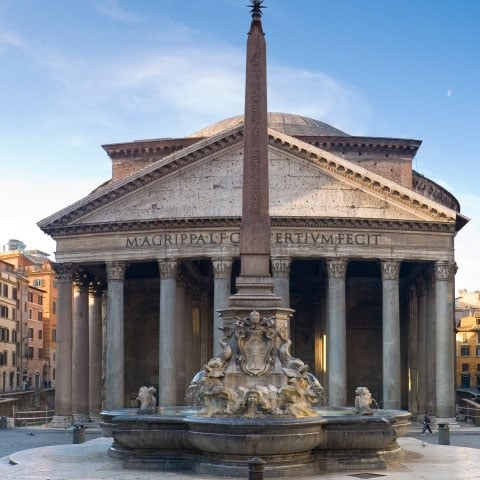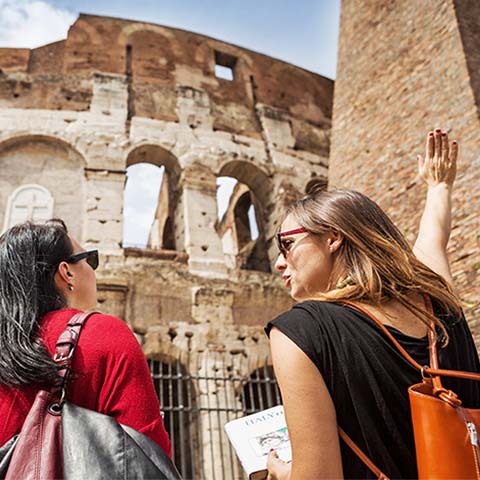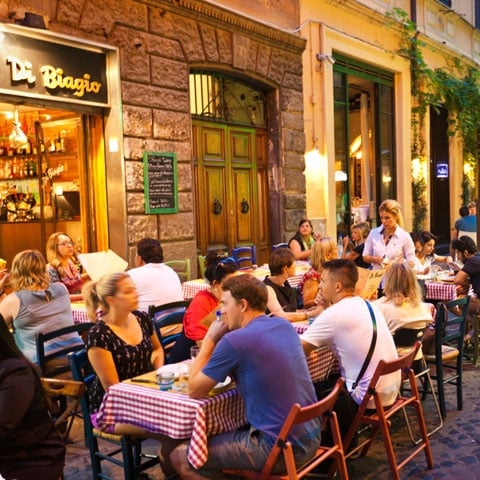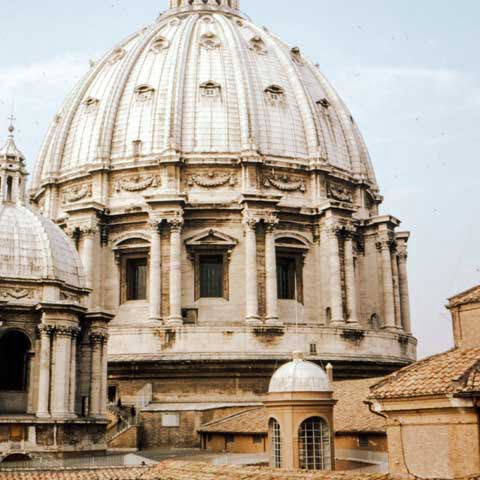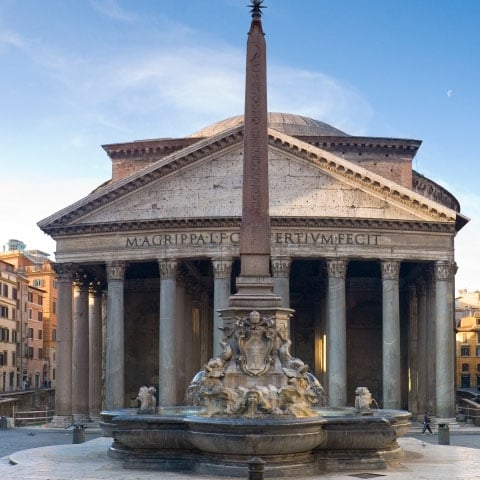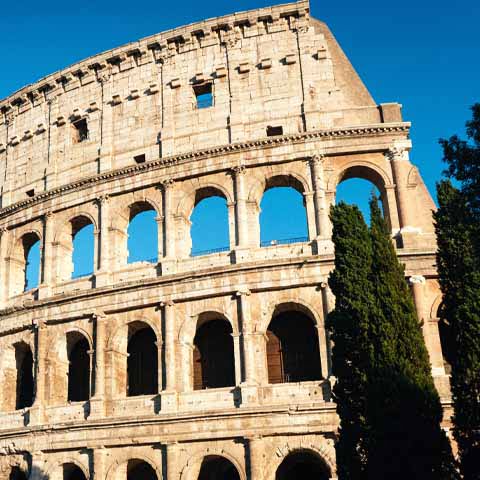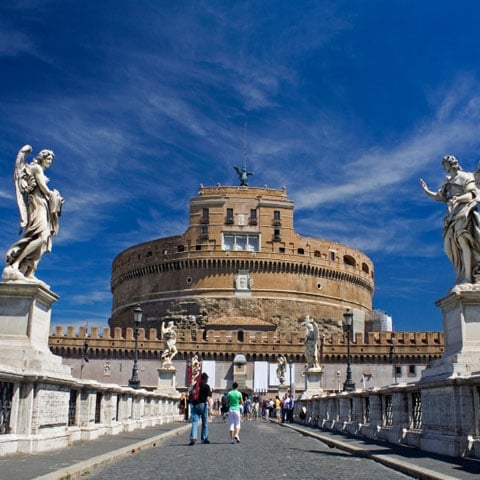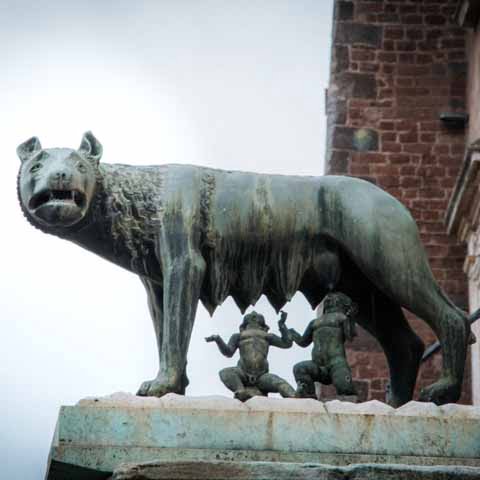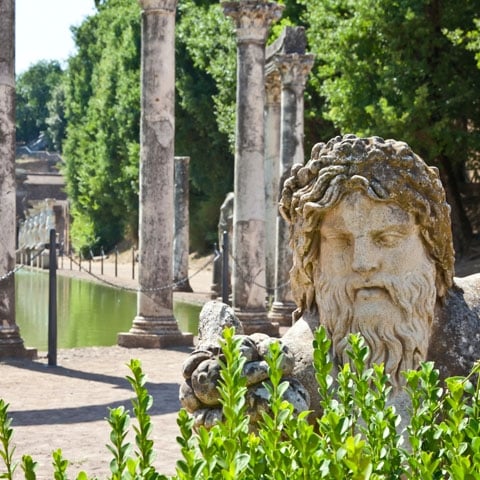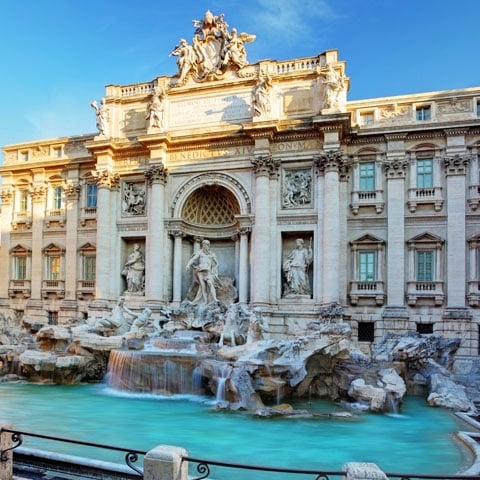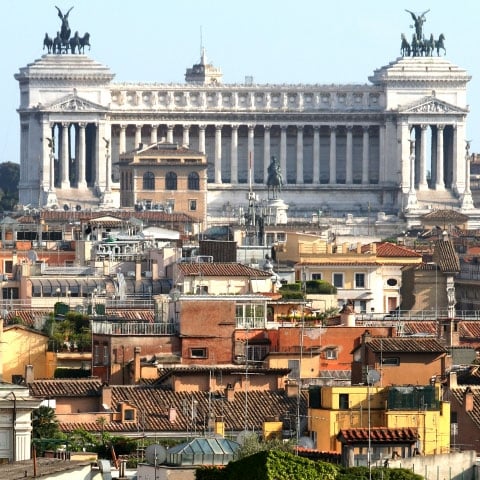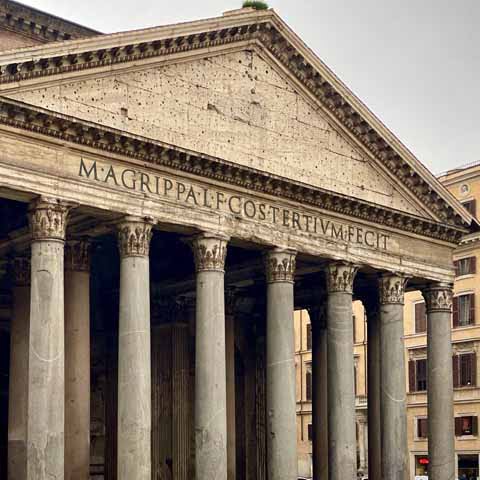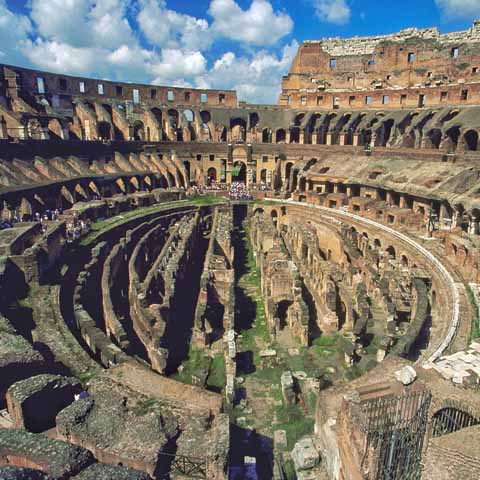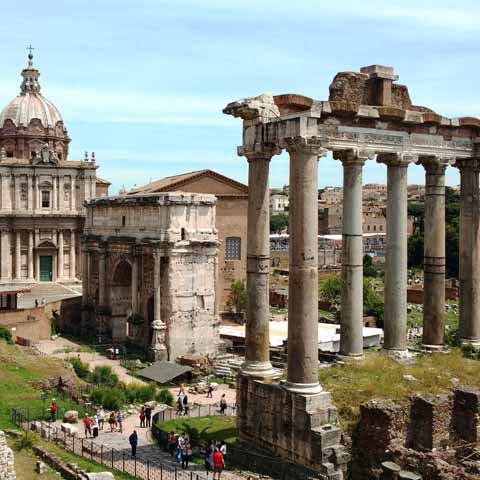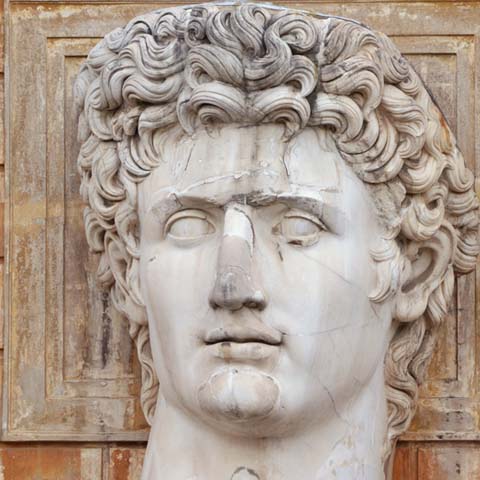Lazio is a peculiar region located in the center of Italy. As a territory, the region doesn’t have a precise geographical unity. The boundaries with its neighboring regions are delimited by an inconsistent succession of mountains and coastal strips, and these characteristics make Lazio a region rich in different landscapes ranging from Apennine peaks to the long Tyrrhenian coasts, the Agro Pontino, or Pontine plains, and the various hilly areas.
Due to its central position in the Peninsula, Lazio has always been an essential cross point for the commercial routes between North and South. Despite being a Tyrrhenian region, the eastern borders are located less than 32 miles from the Adriatic coast.
Thanks to this strategic position, Lazio is characterized by strong cultural bonds with both sides of the country and is often seen as a transition region between northern Italy, Tuscany, Umbria and Campania. These considerations alone are enough to underline the importance of the region within the country. Moreover, the capital of Italy, Rome, is located in Lazio.
This characteristic emphasizes the functional centrality of the region, which has always attracted important commercial flows, individuals, and capital investments.
The name Lazio derives from the ancient Latium and it was initially delimitated by the river Tiber and the Apennines.
Prehistory of Lazio
When it comes to the quantity and significance of the artifacts dating from the different Paleolithic eras, Lazio is one of the best-documented regions in Italy. Some pebble and splinter artifacts discovered in various locations in the province of Frosinone are dated back to the earliest phases of the Paleolithic. With an attested age of about 500,000 years, these are some of the oldest artifacts in Italy and Europe.
Other important findings belong to the Acheulian civilizations and have been found at Fontana Ranuccio, one of the most important archaeological sites in the region. These findings belong to the Lower Paleolithic.
In several sites located near the Tyrrhenian coasts, at only a few miles north from Rome, a series of artifacts belonging to the Upper Acheulian era were discovered. The most important sites from a historical point of view are Torre in Pietra, Castel di Guido, Malagrotta, and La Polledrara di Cecanibbio. The findings in these sites are mostly stratigraphic deposits dated about 200,000 years ago, and they are associated with a few faunal remains from the industries of the era.
Castel di Guido is especially famous for the discovery of evidence of the intense use of large mammal bones as weapons or tools. Many artifacts manufactured from this raw material were also found in other areas in the region.
A few cranial remains and two bone fragments attributable to Homo Erectus were also found at the same site.
Many Acheulian deposits are also present in the province of Frosinone, and there are even some sites packed with evidence of splinter-like industries.
Lazio is also rich in evidence from the Middle Paleolithic era, with many artifacts belonging to the Mousterian civilizations. These artifacts were discovered in several open-air sites in the Pontine plains region and in some caves on Mount Circeo. One of the most famous findings in the region is a skull found on Circeo and two mandibles attributed to the Neanderthals.
The sites in the province of Gaeta are somehow different from the others and are characterized by the use of small siliceous pebbles. This Mousterian technique dates back 50,000 years. Throughout the region, there are many other archaeological sites where the presence of Middle Paleolithic Mousterian industries is well documented, especially in the province of Frosinone.
The subsequent Upper Paleolithic era is also very well documented. Some of the most important findings belong to the Aurignacian and have been identified in the cave of Fossellone.
There are some interesting sites from the Mesolithic era on Mount Circeo and the Polesini cave where numerous manifestations of early art have been discovered. According to the evidence, Lazio has been inhabited in the Neo-Paleolithic and Bronze Age by populations dedicated to agriculture and breeding.
The findings used as evidence were identified in Sasso di Furbara and in Fiora Valley. The latter is also famous for its Rinaldone facies. Historical evidence from this culture are also present in various sites at the north of Rome, in the Roman Agro and in many other places in the region.
A clear cultural diversification between the north and the south bank of the Tiber is documented to the late Bronze Era. Later, the areas were occupied by the Etruscan and Latin civilizations. There are also traces of the early Iron Age documented by the formation of large proto-urban centers, including one of particular historical importance that developed into the future Rome.
History of Lazio
The development of Lazio was marked by the Tiber for many centuries. Dividing the territory between a northern part and a southern one, the river has been a sort of border between different cultures for a long time.
The differences between the two sides are astonishing. The north bank witnessed an early proto-urban development and the rise of a flourishing civilization, the Etruscans. The south bank was originally inhabited by the Latins and other populations grouped in small settlements. The two banks of the river developed independently until the first century BC when, under the new order of Augustus, the north bank became part of Etruria while the south bank, together with Campania, was incorporated in the First Roman region.
It is easy to understand that the Latins played a major role in the early historical events in Lazio, influencing the prosperity of the region between the seventh and sixth centuries BC. Their presence is well evidenced by the tombs of Praeneste.
The Latin League gathered the populations and cities of Latium Vetus, namely the area between the Tiber and Mount Circeo, around the cult of Jupiter and introduced religious celebrations such as Latinae feriae. The league acted as a sort of federal organization and fought many battles alongside Romans against common enemies.
In fact, both Latins and Romans set the basis of many colonies as early as the fifth century BC. The assault of the Gaul against Rome in 390 BC was accompanied by tensions between allies and rebels, which resulted in harsh wars against Latins and other tribes. The Latin League was dissolved in 338 BC after rebelling against the Romans, shortly after the First Samnite war.
From this moment on, Lazio became an integral part of Rome, the powerful city-state which extended its dominion all over Italy, and the world.
With the fall of the Western Roman Empire, the territory of Lazio passed under Byzantine sovereignty. However, the Byzantine Empire didn’t last long in the region. Engaged in defending their northern territories, they overlooked an important aspect in Lazio: the church.
Taking advantage of the events, the Church of Rome established itself in the region and implemented a local autonomy. The Roman Church developed its own economic relationships and set the basis of independent military collaborations, decisions that had a major impact on Lazio’s history.
The efforts of the pontiffs were majorly focused on the reconstruction of the economic assets lost under the Byzantine domination. Through donations and forced restitution of the lands and economic goods, the church established its dominion in the region and the current territory of Lazio became part of the State of the Church.
Between the eighth and ninth centuries AD, the region experienced a strong monastic development. In parallel, the new aristocratic families also gained power and control. As a result, a furious struggle for power between the Church and the Roman municipality weakened the control of both institutions.
The Saracens and Hungarian tribes exploited the opportunity and entered Latium, devastating large parts of the territory and many settlements.
Unwilling to lose its power, the Church reorganized its dominion between the eleventh and twelfth centuries. In parallel, a new aristocracy, closely linked to the Curia, also developed in the region. Opposing the new lead, Rome rebelled in 1143 and established a secular government.
The municipal institutions started to spread in Rome, claiming the right to rule the city in the name of the people in an attempt to provide an early democratic solution to the eternal struggles between Papacy and nobility.
As a result, the whole Lazio region awakened independent forces represented by the feudal lords in the countryside and by the municipal institutions in the cities. The struggles between laics and clerics came to an end in the last part of the twelfth century, when Pope Clement III obtained an agreement with the Roman Senate. However, it was PopeInnocent III who reestablished full papal sovereignty over the whole territory.
Innocent III imposed his authority over the region by claiming respect. The feudal lords and the municipalities in Lazio swore loyalty to the pope and Rome gave up its autonomy, appointing Innocent as the Senator of Rome, the highest rank at the time.
Rome tried to escape the dominion of the Church again in 1234 but failed, and Pope Gregory X divided the region into provinces ruled by rectors and supervised by the Parliament.
Although distributing the power between various institutions, the pope reserved his right to intervene as the supreme authority. As such, the institutions were dwindling under the authority of the Church. Although most municipalities of the region were still against the papal domination, Lazio no longer had an autonomous role and its territory became nothing but a scene for the upcoming events.
Between 1309 and 1377, Avignon abolished papacy. This favored the crystallization of local autonomies which strengthened nobility all over Lazio. However, it also caused an economic and political crisis that led to the formation of new social forces. Together, with the new social forces also emerged new political and antipapal movements towards the middle of the fourteenth century.
The crises and struggles weakened both the nobility and the people, strengthening the papal monarchy once again.
It was the bitter disparities between the noble families that favored the restoration of the papacy and the progressive annihilation of the aristocratic power. In the early decades of the sixteenth century, the victory of the papacy was definitive, and from now on the history of Lazio coincides with that of the Papal State.
One of the most dramatic episodes in Lazio’s history dates back in 1527 when the region was crossed by the mercenary troops of Charles V.
In the seventeenth century, the region witnessed a progressive formation of the Lordships linked to the papal families, in parallel with the decadence of the traditional nobility. In the eighteenth century, the region saw probably the greatest crisis of the Papal State.
1798 marked the beginning of a new political movement linked to the Roman Republic. A strong secularism emerged in Lazio from the second decade of the nineteenth century. Rome and Lazio were annexed to Italy in 1870, but the region benefited only partially from the move of the nation’s capital to Rome, in 1875.
However, Lazio benefited from the Pontine marshes carried out during the Fascism, which gave a significant boost to agriculture. During the Second World War, the region suffered serious damage and several cities were completely destroyed, including Anzio.
The war damaged, above all, the artistic heritage of the region. Various monumental complexes, churches and ancient urban agglomerations were razed to the ground. The long process of reconstruction has focused on the formation of the industrial centers such as Latina and Frosinone. The region also witnessed agrarian reforms and developmental interventions in some areas to the north of Rome.
Since 1948, after the approval of the Constitution, the Lazio region became the protagonist of a considerable economic and social development.
Archaeology in Lazio
Some of the most important archaeological sites in Lazio are linked to the Etruscan centers on the north bank of the Tiber. Among them, Veio is one of the most famous for its clay sculptures found in a temple of Apollo. Other important sites are Tarquinia and Cerveteri. One is known for its amazing painted tombs; the other for its monumental necropolises.
The antique sites of Lavinio and Ardea are also noteworthy. They are strongly connected to the ancient history of Rome and the Latins. Some remains of the great Italian walls can still be found in some parts of Lazio, especially in Arpino, Alatri, and Norba.
The Hellenistic age and the dominance of Rome led to a greater uniformity of the artistic motifs in all regions in Lazio, and it favored the construction of roads such as Appia, Aurelia, and Cassia. There are also remains of the Roman and Latin colonies.
Testimonies of the Roman architecture are present almost everywhere in the region. Noteworthy are the areas of Ostia and the nearby ports of Claudius, as well as some edifices of Trajan, Palestrina, and Civitavecchia. Remains of ancient settlements are also scattered throughout the territory and many sepulchral monuments flank ancient streets.
It’s worth mentioning the Mausoleum of Munazio Planco in Gaeta, but Lazio truly boasts dozens, if not hundreds, of noteworthy places from an archaeological point of view.
Regarding archaeological museums, Lazio has plenty. There are countless open-air or traditional archaeological museums in Rome alone, and almost all municipalities of the region feature museums or open-air sites worth visi
